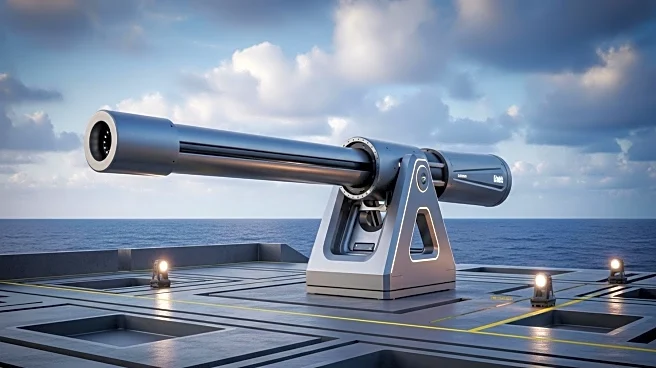What's Happening?
Japan's Acquisition Technology & Logistics Agency (ATLA) has announced the successful test firing of a ship-mounted electromagnetic railgun, marking a significant advancement in military technology. The test, conducted in June and July, involved firing non-explosive projectiles at high speeds from the test ship JS Asuka. This development positions Japan as a leader in railgun technology, which promises long-range, high penetration, and rapid fire capabilities. The railgun can potentially counter hypersonic cruise missiles and enhance anti-ship capabilities. Meanwhile, the U.S. Navy has canceled its railgun project due to budget constraints and integration challenges, leaving a technological gap in its arsenal.
Why It's Important?
The successful test of Japan's railgun underscores a shift in military technology towards electromagnetic power, which offers advantages in speed and penetration over traditional chemical-based weapons. This development could alter naval warfare dynamics, especially in countering advanced threats like hypersonic missiles. For the U.S., the cancellation of its railgun project highlights challenges in innovation and budget prioritization, potentially affecting its competitive edge in military technology. The U.S. Navy's decision to halt railgun development may impact its ability to keep pace with technological advancements made by other nations, such as Japan and China, which are actively pursuing similar technologies.
What's Next?
Japan plans to further discuss its railgun project at the upcoming ATLA Symposium in November, potentially exploring international cooperation with countries like France and Germany. The U.S. may need to reassess its approach to military technology innovation and consider partnerships to bridge the technological gap. As Japan continues to develop its railgun capabilities, it may seek collaboration with the U.S. to enhance guidance systems and power storage, areas where the U.S. has expertise. This could lead to renewed interest in railgun technology and potential joint efforts to counter emerging threats.
Beyond the Headlines
The development of railgun technology by Japan and other nations raises ethical and strategic questions about the future of warfare. The shift from chemical to electromagnetic power could lead to new arms races and necessitate updated international regulations. Additionally, the focus on hypersonic missile defense highlights the growing importance of advanced military technologies in national security strategies. As countries invest in these technologies, there may be broader implications for global military balance and the nature of future conflicts.













